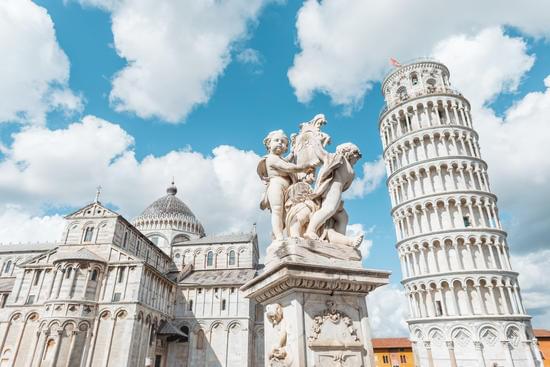Italy has long been a dream destination for many American travelers. From the enchanting cities of Rome, Florence, and Venice to the scenic landscapes of Tuscany and the Amalfi Coast, Italy offers a wealth of cultural experiences and natural beauty. However, since the outbreak of the COVID-19 pandemic, travel restrictions have been in place around the world, including in Italy. US travelers have eagerly awaited news about when they can once again visit this beloved country.
In this article, we delve into the question that has been on every American traveler’s mind: When will Italy allow US travelers? We will explore Italy’s current travel restrictions and the factors that influence their decision to open their borders. Additionally, we will examine how Italy’s COVID-19 situation plays a significant role in determining when US travelers may be allowed entry.
Understanding what requirements US travelers may face when Italy opens its borders is crucial for planning future trips. We will highlight potential travel requirements that could be imposed on US citizens, such as testing or vaccination protocols. By staying informed about these requirements, travelers can adequately prepare themselves for their Italian adventure once it becomes possible.
Throughout this article, we will provide insights from experts and examine any previous updates or announcements made regarding the possibility of US travelers being allowed into Italy. Moreover, predictions from these experts will be discussed to give readers an idea of when they might finally get to experience all that Italy has to offer.
Stay tuned as we explore all aspects related to when Italy will allow US travelers. We hope to provide you with valuable information and resources necessary for planning your dream trip to this extraordinary country once again.
Current travel restrictions
Italy has implemented several travel restrictions in response to the COVID-19 pandemic. Currently, Italy allows entry for essential reasons only, and leisure or tourist travel is not permitted for travelers from most countries, including the United States.
As of now, Italy has a list of countries classified as “high-risk” where non-essential travel is restricted. The list is updated regularly based on the epidemiological situation of each country. The specific travel restrictions and requirements vary depending on the classification of a country.
For travelers coming from high-risk countries, including the US, currently allowed to enter Italy are Italian citizens, residents of Italy or those with essential reasons such as work, health, or study purposes. These travelers are required to present a negative COVID-19 test result taken within 48 hours before arrival and undergo quarantine upon entering Italy.
It’s important for US travelers to stay informed about the latest updates regarding travel restrictions in Italy. The situation is dynamic and subject to change based on the evolving COVID-19 situation globally. Travelers are encouraged to regularly check with their local embassy or consulate for the most up-to-date information before planning their trip.
Here is an overview of Italy’s current travel restrictions for US travelers:
Requirement
Details
Negative COVID-19 test
US travelers must provide a negative COVID-19 PCR or antigen test result taken within 48 hours before arrival.
Quarantine
US travelers are required to undergo a 14-day quarantine period upon entering Italy. However, some regions may have specific guidelines that could allow for a shorter quarantine period.
Essential reasons only
Leisure or tourist travel is not allowed for US travelers at this time. Only those with essential reasons such as work, study, or health purposes are permitted.
It’s important to note that these requirements may change depending on the pandemic situation and government regulations. Therefore, it’s crucial for US travelers to stay updated with reliable sources and official announcements from Italian authorities.
Factors influencing Italy’s decision
Italy’s decision to allow US travelers is influenced by a variety of factors. These factors are crucial in determining when Italy will open its borders and welcome back tourists from the United States. Understanding these considerations helps provide insights into the timeframe for when Americans can expect to visit Italy again.
Vaccination rates and COVID-19 variants
One of the key factors that Italy takes into account is the vaccination rates both in Italy and in the United States. The effectiveness of vaccines in controlling the spread of COVID-19 is a top priority for any country considering reopening its borders. Italian authorities closely monitor vaccination progress, particularly in relation to emerging COVID-19 variants.
Italy may also consider specific travel restrictions based on regions within the United States that have higher instances of COVID-19 or concerning variants. This could include requirements for additional testing or quarantine measures for travelers from specific areas with high transmission rates.
Reciprocity and bilateral agreements
Another significant factor influencing Italy’s decision is reciprocity between countries. Italy may consider allowing US travelers if there is evidence that the United States has relaxed its own travel restrictions on Italian citizens. Reciprocal agreements prioritize fairness and equal treatment between nations when it comes to international travel.
Bilateral discussions between Italy and the United States are ongoing, focusing on finding common ground regarding entry requirements, health protocols, and other necessary measures. The outcome of these discussions will play a crucial role in determining when Americans can travel to Italy again.
Evaluation of public health conditions
Italy constantly evaluates its public health situation, assessing the number of new infections, hospitalizations, and overall trends in disease transmission. The country considers data related to active cases, positivity rates, and healthcare system capacity to determine whether it is safe to welcome visitors from different countries, including the United States.
If Italy observes sustained positive trends with declining infection rates, increasing vaccination coverage, and minimal strain on healthcare resources, it may be more inclined to lift travel restrictions. However, the decision will ultimately depend on Italy’s confidence in containing any potential surges in cases that may occur with the reintroduction of international travel.
As Italy continues to navigate the complexities of reopening its borders to US travelers, considering these factors will help provide some clarity on when Americans can once again experience the beauty and culture of Italy. It is essential for travelers to stay informed about updates from both Italian and US authorities as guidelines may change depending on various circumstances.
Italy’s COVID-19 situation
Italy’s COVID-19 situation plays a significant role in determining when the country will allow US travelers. As one of the hardest-hit countries during the early stages of the pandemic, Italy has implemented strict measures to control the spread of the virus. The decision to open its borders to US travelers depends on various factors related to Italy’s COVID-19 situation.
- Infection rates: Italy closely monitors its daily infection rates and trends. Before allowing US travelers, Italy wants to ensure that the number of COVID-19 cases is consistently declining and under control.
- Vaccination progress: The rate of vaccinations in Italy also impacts its decision regarding US travelers. As more Italians receive their vaccines, the country becomes more confident in easing travel restrictions.
- Mutant strains: Italy considers the presence and impact of mutant strains within its borders. If there are concerns about highly contagious variants, it may delay or reconsider opening up to US travelers.
- Hospital capacity: A crucial factor is ensuring that Italian healthcare systems have enough capacity to handle any potential increase in COVID-19 cases due to incoming US travelers.
It is important for US travelers to keep track of Italy’s COVID-19 situation as it directly impacts their ability to visit. As infection rates decrease and vaccination efforts progress, there is hope for a future where US travelers can once again explore the beautiful cities and landscapes of Italy.
However, it’s important to note that these factors can change over time depending on how the COVID-19 situation evolves globally. Travelers should regularly check official sources such as the Italian Ministry of Health, Italian embassies or consulates in their home countries, and trusted travel advisories for updates on Italy’s COVID-19 situation and travel restrictions.
By staying informed and following the guidelines and requirements set by Italian authorities, US travelers can hopefully plan their dream trips to Italy when the time is right.
Travel requirements for US travelers
When Italy eventually opens its borders to US travelers, it is essential for prospective visitors to understand the potential travel requirements that may be imposed. These requirements are put in place to ensure the safety and well-being of both tourists and residents during these challenging times. While specific details are subject to change, here are some potential travel requirements that US travelers may need to adhere to when visiting Italy:
- COVID-19 Testing: It is highly likely that US travelers will need to provide proof of a negative COVID-19 test result taken within a certain timeframe before their departure to Italy. This measure is aimed at preventing the importation of the virus. Travelers may be required to present their negative test results upon arrival in Italy or even submit them prior to boarding their flight.
- Health Screening and Temperature Checks: To further mitigate the risk of spreading COVID-19, US travelers might undergo health screenings and temperature checks upon arrival in Italy. These measures are put in place as an additional layer of protection for both visitors and locals.
- Quarantine or Isolation Periods: Depending on the prevailing COVID-19 situation at the time, US travelers may be required to undergo a period of quarantine or self-isolation upon arrival in Italy. The duration of this period is subject to change based on evolving circumstances, so it is crucial for travelers to stay informed about the latest guidelines and directives from Italian authorities.
- Contact Tracing and Registration: In order to facilitate contact tracing efforts, US travelers might be asked to register their personal information with Italian health authorities upon arrival or through an online platform before their trip. This will help health officials quickly identify and inform individuals who may have come into contact with someone infected with COVID-19 during their visit.
It’s important for US travelers considering a trip to Italy once the borders open again to closely monitor official government websites, such as the Embassy of Italy in Washington D.C., for up-to-date information on travel requirements. Additionally, it is advisable to consult with travel agencies or airlines for any specific guidelines they may have in place. By staying informed and prepared, US travelers can ensure a smoother and safer experience when visiting Italy in the future.
Previous updates on US travel restrictions
Previous updates
Since the beginning of the COVID-19 pandemic, Italy has implemented strict travel restrictions to prevent the spread of the virus. Initially, Italy banned entry for travelers from certain countries, including the United States, due to their high infection rates. However, as the global situation improved and vaccination rates increased, Italy started to ease its travel restrictions.
In recent months, there have been several updates and announcements regarding the possibility of US travelers being allowed in Italy. The Italian government has been closely monitoring the situation and adapting its policies accordingly. As a result, there have been some positive developments indicating that Italy is moving towards permitting US travelers in the near future.
Progress made
One significant update came on May 16th when Italy announced that international leisure travel will be possible for those who have received an approved COVID-19 vaccine or have tested negative for the virus. This announcement was an important step forward and raised hopes for US travelers looking to visit Italy.
However, it’s essential to note that this decision was not solely focused on US travelers but applied to all international tourists. Therefore, while it indicated progress, it did not specifically address when US travelers would be allowed in Italy.
Another significant development occurred on June 21st when Italy introduced a digital COVID-19 passport called “Green Pass.” This pass allows individuals who are fully vaccinated, recovered from COVID-19, or have tested negative within a certain timeframe to enjoy several privileges, including unrestricted travel within Italy and Europe. While this predominantly applies to EU citizens at present, there is hope that it may extend to non-EU countries like the United States soon.
The road ahead
Italy considers various factors before deciding to allow visitors from a specific country. These factors include the overall COVID-19 situation in that country, vaccination rates among its population, and any emerging variants of concern. By closely monitoring these factors and evaluating their impact, Italy continues to assess when it will feel comfortable opening its borders to US travelers.
While there have been notable updates and positive steps towards allowing US travelers in Italy, it is challenging to provide an exact timeline. However, experts and analysts remain cautiously optimistic that with the progress being made globally in controlling the virus, it might be possible for US travelers to visit Italy in the not-too-distant future.
As the situation evolves, it is essential for prospective travelers to stay informed and keep an eye on official announcements from both the Italian and US governments.
Predictions and experts’ opinions
As the COVID-19 pandemic continues to evolve, people around the world are eagerly awaiting news about when Italy will open its borders to US travelers. While there is no definitive answer, experts and analysts have provided their predictions and opinions on when this may happen.
One of the important factors that experts consider is the vaccination rates in both countries. As more individuals receive COVID-19 vaccinations, it is expected that travel restrictions will ease.
According to Dr. Anthony Fauci, the United States’ leading expert on infectious diseases, widespread vaccinations could lead to a significant relaxation of travel restrictions by late summer or early fall. This aligns with the Italian government’s goal of vaccinating at least 80% of its population by the end of September.
Another crucial aspect that experts take into account is the overall COVID-19 situation in both Italy and the United States. As infection rates decline and containment measures prove effective, there may be greater confidence in allowing international travel. Currently, Italy has been cautiously reopening certain sectors amidst its improving COVID-19 situation, which provides hope for potential easing of travel restrictions in the future.
Despite these factors, it is important to note that predictions regarding Italy’s decision to allow US travelers are subject to change based on current circumstances and new developments. It is essential for travelers to stay informed with reliable sources such as official government announcements and international health organizations.
| Resource | Description |
|---|---|
| Embassy of Italy in Washington D.C. | The official website of the Embassy provides information on visa requirements and any updates on travel restrictions. |
| U.S. Department of State – Italy Travel Advisory | The U.S. Department of State provides travel advisories and updates for Italy, including any restrictions related to COVID-19. |
| World Health Organization (WHO) | The WHO offers global health information and guidance, including updates on the COVID-19 situation in Italy. |
While experts have provided their insights, it is important to remember that the decision to allow US travelers ultimately rests with Italian authorities who prioritize public health and safety. Continuous monitoring of the situation and adherence to guidelines will help determine when US travelers can expect to visit Italy again.
Resources to stay informed
Staying informed about the latest developments regarding Italy’s travel restrictions for US travelers is crucial for those who are eagerly waiting to visit the country. With travel guidelines and regulations subject to change, it is essential for travelers to have access to reliable resources that can provide up-to-date information. Fortunately, there are several sources available that can help individuals stay informed and plan their trips accordingly.
One of the most reliable sources for current travel information is the official website of the Italian government. The Ministry of Foreign Affairs and International Cooperation regularly updates its website with the latest travel advisories, entry requirements, and any changes in restrictions. Visitors can find detailed information about visa requirements, COVID-19 testing protocols, and quarantine regulations.
International news outlets also play a significant role in keeping people informed about Italy’s travel restrictions. Major news organizations such as CNN, BBC, and Reuters often report on any significant updates or changes in travel policies for different countries, including Italy. Checking these news websites regularly or signing up for their newsletters can help travelers receive timely updates directly in their inbox.
Additionally, it is important to follow reputable travel blogs or websites that specialize in providing information on travel restrictions during the pandemic. Websites like Travel + Leisure and Lonely Planet have dedicated sections that cover specific COVID-19 related travel updates for different countries, including Italy. These platforms often include expert opinions and insights on when certain countries may reopen their borders to US travelers.
Lastly, social media platforms can be valuable resources for staying informed about Italy’s travel restrictions. Following official accounts of Italian government agencies or tourism boards on platforms like Twitter or Facebook can provide real-time updates and announcements regarding any changes in travel policies. Joining relevant online communities or groups can also allow travelers to connect with others who are facing similar challenges or seeking information about traveling to Italy.
By utilizing these resources and staying updated on the latest developments regarding Italy’s travel restrictions for US travelers, individuals can effectively plan their trips and make informed decisions based on accurate and timely information. It is important to remember that the situation remains fluid, and it is advisable to regularly check these sources for any changes or new guidelines before making travel arrangements.
Conclusion
In conclusion, the article explored the expectancy of Italy opening its borders to US travelers. We reviewed Italy’s current travel restrictions and discussed the factors that influence its decision to allow US travelers. Additionally, we examined how Italy’s COVID-19 situation plays a role in determining when US travelers may be welcomed back.
It is important to note that as of now, Italy has not provided a set date for when it will allow US travelers. However, experts and predictions suggest that with the continuous progress in vaccinations and declining cases in both countries, there is hope for a reopening in the near future.
When Italy does open its borders to US travelers, it is likely that there will be travel requirements in place to ensure health and safety for all individuals involved. These requirements may include proof of vaccination, negative COVID-19 tests, or other health screening procedures. It is advisable for prospective US travelers to stay informed on any updates regarding these travel requirements by utilizing resources such as official government websites and trusted news sources.
In closing, while we eagerly anticipate the day when US travelers can visit Italy again, it is crucial to prioritize safety and adhere to any guidelines or restrictions put in place. By staying informed through reliable resources and closely monitoring developments in both countries’ COVID-19 situations, we can better prepare for future travels and ensure a smooth return to exploring the beautiful landscapes and rich cultural experiences that await us in Italy.
Frequently Asked Questions
Does Italy allow US citizens to travel?
Yes, Italy allows US citizens to travel. However, it is important to note that the specific entry requirements and restrictions may vary based on factors such as the purpose of travel (e.g., tourism, business) and the evolving COVID-19 situation.
Generally, US citizens visiting Italy will need a valid passport for the duration of their stay, and depending on the length of the visit, they might also need to obtain a visa or meet additional requirements upon arrival.
What is the new update for Italy immigration 2023?
Unfortunately, without any specific information regarding the new update for Italy immigration in 2023, it is difficult to provide accurate details about any changes that may be in place. Immigration policies can often undergo revisions or updates according to various factors such as national security concerns, economic conditions, or political priorities.
It would be advisable to refer to reliable official sources like the Italian Ministry of Foreign Affairs or embassy/consulate websites for up-to-date information on any upcoming immigration changes for Italy in 2023.
Is Italy safe to travel 2023?
As of now, it is challenging to predict with certainty if Italy will be safe to travel in 2023 due to factors like unforeseen developments related to health risks (including COVID-19), social unrest, or other security concerns. Safety conditions can vary throughout different regions and cities within Italy as well. It is always recommended to monitor official travel advisories from relevant authorities such as the U.S. Department of State or your own government’s foreign affairs department before planning a trip.
These sources usually provide valuable information concerning safety measures and timely updates on potential risks that could impact travel plans to Italy or any other destination. Additionally, staying informed and following local guidelines and regulations during your stay is essential for minimizing potential risks while traveling abroad.

I’m a passionate traveler, writer, and Italophile. My fascination with Italy’s history, art, and culture has led me on countless adventures across the Italian landscape. Through “I Live Italy,” I share my love for this extraordinary country and aims to inspire others to explore its boundless beauty.





